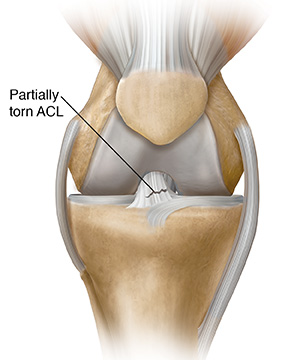Thermal Shrinkage for Anterior Cruciate Ligament (ACL) Repair
The ACL is a band of tough, fibrous tissue that stabilizes the knee. Injuries to the ACL are very common—especially among athletes. Most often, the injury happens when the knee is forced beyond its normal range of motion. This can stretch or tear the ligament, much like the fibers of a rope coming apart. You may have pain and swelling and feel like your knee “gives out.” A treatment called thermal shrinkage can help repair a partially torn ACL. Thermal shrinkage is one of several surgical and nonsurgical treatments for a partially torn ACL.
Thermal shrinkage therapy
Heating parts of the partially torn ACL causes them to shrink. This tightens the ligament and allows it to better stabilize the joint. Thermal shrinkage is done during an arthroscopic procedure. A long, thin, lighted tube called an arthroscope is inserted into the knee joint and used to see and operate inside the knee. Other surgical and nonsurgical choices are used for a completely torn ACL.
Before the procedure. Follow your surgeon’s instructions on how to prepare for the procedure. Follow any directions you are given for not eating or drinking before surgery. Discuss any medicines you take with your surgeon to determine whether you need to stop. When you arrive at the hospital or surgery center, you will change into a hospital gown. You will be given medicine to relax you. You may be given other medicines, such as antibiotics. You may be partially awake or completely asleep during the procedure, depending on the type of anesthesia chosen.
During the procedure. Small incisions are made around your knee. The arthroscope and surgical instruments are placed through these incisions. Magnified images of your knee joint appear on a monitor. To do thermal shrinkage, the surgeon inserts a probe into the joint. This probe heats specific parts of the ACL. When these parts cool, they shrink, causing them to tighten and better hold the joint in place.
After the procedure. You will go home the day of the procedure or stay 1 night. You will be given a rehabilitation program of exercises and physical therapy to strengthen your knee. This program may continue for 3 to 6 months. You will be given different choices for pain management.
Risks and complications of thermal shrinkage
These include:
Infection
Nerve damage
Failure to tighten the ACL
Restretching or retearing of the ACL
Limitation in range of motion
Call your healthcare provider
Contact your healthcare provider if:
You have increasing pain or swelling in your knee or calf
You have decreasing sensitivity or movement in your knee
You have a fever of 100.4°F (38°C) or higher, or as directed by your healthcare provider
